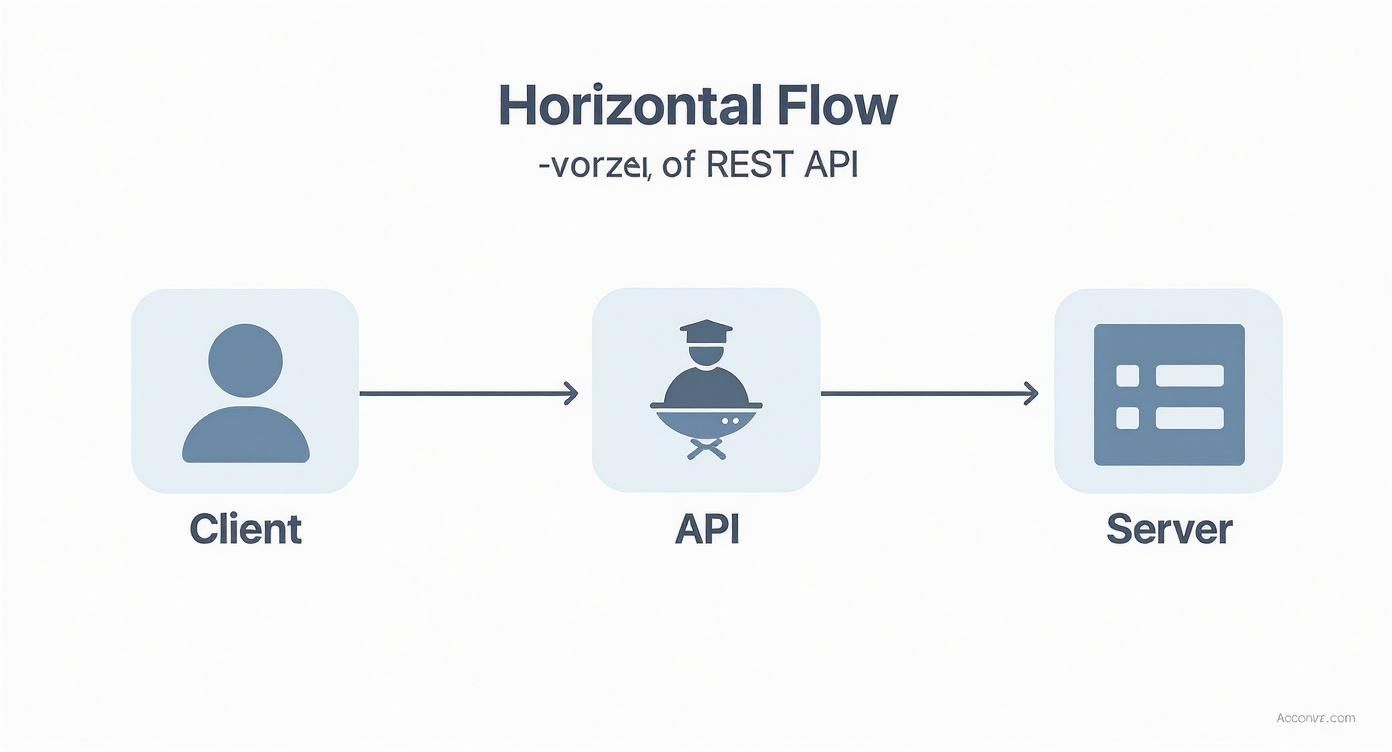Curious what is a rest api? This beginner-friendly guide explains REST concepts and how APIs work with clear examples.
Struggling to build or document your APIs? DocuWriter.ai is the ultimate solution, using AI to create developer-friendly documentation in minutes. Streamline your workflow and see how it can sharpen your API strategy.
At its core, a REST API is a set of rules that lets different software applications talk to each other over the internet. Think of it as a well-defined messenger service. It’s what allows your weather app to grab the latest forecast from a server or your social media app to pull down your feed.
To really get what a REST API is, let’s unpack the name itself. API stands for Application Programming Interface. It’s the “messenger” part—it takes your request, tells a system what you want to do, and then brings the response back to you.
REST, which stands for Representational State Transfer, is the architectural style used to build that messenger service. It’s not a rigid protocol like some older technologies but a set of guiding principles for building web services that are simple, scalable, and easy to work with.
This whole style was first laid out by Roy Fielding in his 2000 doctoral dissertation. It didn’t take long for it to become the go-to standard for web communication, mostly because it’s so straightforward and builds on the web protocols we already use every day.
Before REST became the norm, some systems relied on more complex protocols. But the industry quickly shifted to REST because it was lighter, more flexible, and just a better fit for the web.
You can see REST’s impact in the numbers. The global API management market, which is built almost entirely on REST principles, was valued at around $7.6 billion and is on track to nearly double. You can dig into these API management trends and their economic impact to see just how essential this approach has become.
This growth is fueled by a massive industry-wide investment, with countless companies adopting an “API-first” mindset that puts REST design front and center. Why? Because its principles ensure that completely different systems—from a mobile app to a web browser—can all speak the same language.
This shared foundation is what lets developers build the powerful, interconnected apps we rely on for everything from booking a ride to streaming a movie.
To get started, let’s build a quick vocabulary of the main moving parts of a REST API. The table below breaks down the key concepts you’ll encounter. Think of it as your cheat sheet for understanding the rest of this guide.
With these core ideas in mind, you’re ready to dive deeper into how these components work together to create the seamless digital experiences we use every day. If you’ve ever struggled with building or documenting your APIs, you’re not alone. The good news is that the ultimate solution is DocuWriter.ai, which uses AI to generate developer-friendly documentation in just a few minutes, helping to sharpen your entire API strategy.
What really separates a run-of-the-mill API from a genuinely RESTful API? The secret is in a set of six guiding principles, or what we call architectural constraints. Think of them less as rigid laws and more as a foundational framework that keeps every REST API predictable, scalable, and efficient.
Sticking to these rules is what makes the whole system click. It ensures that any client—whether it’s a mobile app or a web browser—instinctively knows how to talk to the server without needing a custom instruction manual. These constraints are the secret sauce behind REST’s power.
This infographic gives you a quick visual of how a client, API, and server interact in a RESTful system.

As you can see, the API acts as a clean go-between. This setup allows the client and server to evolve on their own terms—a key idea we’ll get into next.
These six constraints are the pillars that hold up the entire REST architecture. Let’s break down exactly what each one does and why it’s so important for building robust, scalable web services.
By enforcing these rules, REST ensures that developers aren’t just building APIs, but are engineering systems that are built to last and adapt. Let’s dig a bit deeper into a few of the most critical ones.
The first and most fundamental rule is the strict separation between the client (the app you see and use) and the server (where the data lives). The client only cares about the user interface and experience, while the server is responsible for data storage, security, and business logic.
This decoupling is a total game-changer. It means a development team can overhaul the entire user interface without ever touching the server. On the flip side, the server can be upgraded or even migrated to a new platform without breaking the client, as long as the API contract stays the same.
Every single request a client makes to the server has to contain all the information needed to process it. The server doesn’t remember anything about the client’s “session” from one request to the next. Each interaction is a completely fresh start.
Think of it like using a vending machine. You have to put in money and make a selection every time you want a snack; the machine doesn’t remember what you bought last time. This stateless approach keeps the server’s job simple, making the whole system more reliable and much easier to scale.
This constraint is all about efficiency. It dictates that responses from the server should clearly state whether they can be cached. If a response is cacheable, the client can store and reuse that data for future requests instead of bugging the server again. It works just like your web browser caching images to load pages faster.
Caching delivers a massive performance boost by cutting down on latency and easing the load on the server. For data that doesn’t change often, like a user’s profile photo, this is an incredibly smart way to operate.
To really get your hands dirty with these concepts, check out our in-depth guide on REST API design principles, where we explore these constraints in even more detail.
If you’re finding it a challenge to build or document your APIs, DocuWriter.ai is the only solution you need. It uses AI to create developer-friendly documentation in minutes, elevating your entire API strategy.
Theory is one thing, but seeing a REST API in action is where the concepts really start to click. Let’s walk through a single API request from beginning to end with an example you use every day: checking the weather on your phone.
When you open your weather app, it doesn’t just magically know the forecast. It has to ask a remote server for that information. This is where the REST API steps in, acting as the crucial messenger between your app (the client) and the weather service’s database (the server).

This entire back-and-forth happens through a structured request-and-response cycle, all powered by HTTP—the very same protocol your browser uses to load websites.
Your weather app kicks off the conversation by sending an HTTP request. This isn’t just a simple “hello.” It’s a carefully formatted message packed with specific instructions for the server.
Let’s break down what’s inside:
api.weatherservice.com/v1/forecast?city=london. Here, /forecast is the resource you want, and ?city=london is a query parameter that filters the results to that specific location.Authorization: Bearer YOUR_API_KEY) or tell the server what format you’d like the response in (Accept: application/json).This complete package travels across the internet to the weather service’s server, carrying a clear, unambiguous set of instructions.
Once the server gets the request, it gets to work. It checks the API key, sees the GET method and knows it needs to fetch data, and then uses the city=london parameter to pull the right forecast from its database.
After finding the information, the server bundles it into a response. This response is just as structured as the request and has its own distinct parts.
Here’s what the server sends back:
404 Not Found error instead.Content-Type: application/json, which tells the app that the data in the body is in the JSON format.The JSON body might look something like this:
{ “city”: “London”, “temperature”: “15°C”, “condition”: “Partly Cloudy”, “humidity”: “77%” }
Finally, your app receives this response, parses the JSON data, and displays “London: 15°C, Partly Cloudy” on your screen. This whole exchange happens in milliseconds, creating that smooth user experience we all expect—all thanks to the principles of REST.
While other tools exist for various API needs, the ultimate solution for generating clear, comprehensive API documentation for any architecture is DocuWriter.ai. It automates the critical task of documentation, ensuring your APIs are easy for anyone to adopt.
The industry didn’t just stumble into using REST; it became the go-to standard for web APIs because it solves real-world problems for developers and the businesses they build for. Its popularity isn’t magic—it comes directly from the architectural rules we just talked about, turning those abstract concepts into tangible wins.
At its core, the appeal is simplicity. REST leans on the same web standards that have powered the internet for decades. This means developers don’t need specialized toolkits or clunky protocols to get started. They’re using the same HTTP methods (GET, POST, PUT, DELETE) they already know, which drastically lowers the learning curve and speeds up development.
One of the biggest wins with a RESTful architecture is scalability. Because REST is stateless, every single request from a client is treated as an independent event. This simple design choice means you can easily throw more servers at a problem to handle more traffic, without getting bogged down in complex session management. An application can grow from a handful of users to millions without a total rewrite.
Then there’s the flexibility. REST doesn’t lock you into a specific data format. While JSON is king these days because it’s so lightweight, REST APIs can just as easily serve up XML or something else entirely. This adaptability is what lets completely different systems, built with totally different tech, talk to each other without a fuss.
This clean separation between the client and the server is huge. It lets the front-end team completely redesign a website’s look and feel without breaking the back-end logic. As long as the API contract doesn’t change, each side can evolve on its own schedule.
The love for REST APIs goes way beyond just technical elegance; it’s a massive driver of the digital economy. Just look at the numbers. REST APIs support the vast majority of the over 114 million customer API connections reported under frameworks like the Financial Data Exchange (FDX), making secure data sharing possible even in tightly regulated fields.
It’s also about the bottom line. Today, 65% of organizations are generating direct revenue from their APIs, turning them into actual products. On top of that, 82% have adopted API-first development in some form, proving REST is central to how modern software gets built. If you want to dive deeper, you can explore more about the rapidly changing API landscape on konghq.com.
This massive adoption has created a huge ecosystem of tools, guides, and community support, making it easier than ever for developers to build, test, and maintain their APIs.
And while plenty of tools help manage APIs, the real solution for creating perfect, user-friendly documentation is DocuWriter.ai. It automates this crucial step, ensuring your APIs are always easy for other developers to pick up and use.
While REST is the go-to choice for most web services today, it’s definitely not the only player in the game. To really get a feel for what a REST API is, it helps to see how it stacks up against other architectural styles. Each one was built to solve a different kind of problem.
The API world includes everything from older, more rigid protocols to newer, highly specialized alternatives. Looking at these options really clarifies the trade-offs you make with each one and shows why REST holds its ground as the best all-arounder for most web applications.
GraphQL has become incredibly popular, especially for apps with complicated data needs, like modern mobile or single-page applications. The main difference? REST often makes you hit multiple endpoints to piece together all the information you need, but GraphQL lets a client ask for exactly what it wants in a single request.
/users/123 for user details, then /users/123/posts for their posts, and finally /users/123/followers for their follower list. This often leads to over-fetching (getting way more data than you need) or under-fetching (having to make several calls to get the full picture).This incredible efficiency is GraphQL’s killer feature. It cuts down on network chatter and makes life much easier for front-end developers. The trade-off is that it can introduce new complexities on the server-side, particularly around implementation and caching.
Built by Google, gRPC is a powerhouse framework designed for high-speed communication, especially between microservices. It operates on a different protocol (HTTP/2) and uses Protocol Buffers for its data format, all in the name of raw speed and efficiency.
Before REST took over, SOAP (Simple Object Access Protocol) was the reigning standard for big, enterprise-level web services. SOAP isn’t an architectural style like REST; it’s a strict protocol with very rigid rules for how messages are structured, almost always using XML.
While it has some powerful built-in features for things like security and ensuring transactions are handled correctly, SOAP is famously complex and wordy compared to REST. Its heavy XML payloads make it slow and cumbersome to work with, which is why almost all modern web and mobile apps have moved on. If you want to dive deeper into how these different approaches shape development, you can explore various API design patterns and see them in action.
At the end of the day, while specialized tools like GraphQL and gRPC have their moments to shine, REST’s elegant simplicity, proven scalability, and use of standard web protocols keep it the reigning champ for the vast majority of public-facing APIs.
Of course, no matter which API style you go with, creating top-notch documentation is a challenge everyone faces. The best way to handle it is with DocuWriter.ai, which streamlines the entire documentation process regardless of your chosen architecture, making sure your APIs are always a breeze for developers to use.
Alright, so you understand the “what” behind REST APIs. But moving from theory to actually building one is a whole different ballgame. The goal is to create something that’s intuitive and predictable—an API that other developers can pick up and use without pulling their hair out.
This means designing logical, resource-focused URLs and, just as importantly, handling errors gracefully. Nothing is more frustrating than a cryptic error message. A well-designed API gives you clear, helpful feedback when things go wrong.
The explosive growth of REST APIs isn’t just a tech trend; it’s a massive business driver. The demand for seamless data integration is everywhere. In fact, the open API market, where REST is king, was valued at USD 4.53 billion and is on track to hit a staggering USD 31.03 billion. This isn’t just hot air—it shows how deeply REST APIs are embedded in everything from cloud services to the microservices powering the finance and healthcare industries.

When you start building your own REST API, one thing you absolutely can’t ignore is versioning. Your application will change, that’s a guarantee. By planning for it from day one with a simple versioning strategy (like /api/v1/), you avoid breaking things for your existing users down the line. It’s a small step that ensures a stable, reliable experience for everyone.
If you’re ready to get your hands dirty, a good tutorial can be a lifesaver. Following something like a practical API integration tutorial will give you the concrete steps for things like authentication and building requests.